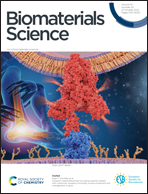Facile fabrication of chitin/ZnO composite hydrogels for infected wound healing†
Abstract
When ordinary wounds are infected, the skin's self-healing capacity declines; thus appropriate dressings with both antibacterial ability and healing ability for bacteria-associated wounds are indispensable. In this work, multifunctional chitin/ZnO composite hydrogels have been designed as an infected full-thickness skin wound-healing material. The hydrogels are fabricated by a facile one-pot strategy through the sequential addition of commercial ZnO powders into aqueous alkaline chitin solutions, crosslinking and regeneration. The regenerated nanoscale ZnO particles aggregate into microscale particles and are embedded in the chitin matrix with tight interactions, including hydrogen bonding and coordination interactions. The decoration of ZnO endows the chitin/ZnO composite hydrogels with excellent antibacterial activity against Escherichia coli (E. coli) and Staphylococcus aureus (S. aureus), with acceptable biocompatibility. More importantly, the chitin/ZnO composite hydrogels show an outstanding accelerated infectious full-thickness wound-healing performance with more fibroblast proliferation, more collagen deposition, and more neogenesis of the epithelium and granulation tissue. Therefore, it is expected that the chitin/ZnO composite hydrogels can serve as competitive skin wound dressings for the prevention and control of infections.



 Please wait while we load your content...
Please wait while we load your content...